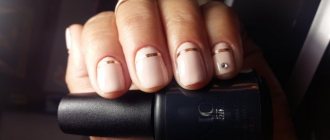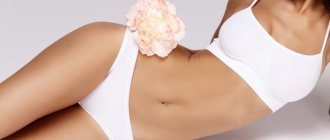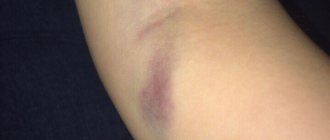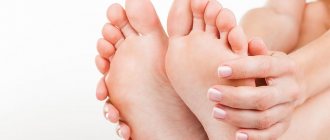Changes in nail color are called onychodyschromia. One of the variants of onychodyschromia is yellowing of the nail plate. It is caused by various reasons: from improper care, the use of decorative varnish, lack of vitamins to diseases of internal organs. Some of them are easy to eliminate on your own, others require treatment from a podologist or dermatologist. Often when nail color changes, other symptoms are present. For example, deformation, thickening, delamination of the plate, appearance of grooves.
Causes of yellowed nails
Only a doctor can make an accurate diagnosis after conducting a series of studies. The yellowness of the plates indicates the presence of sand, stones in the kidneys, damage to the body by hepatitis, and other disorders of liver function. Most often, such pathologies are accompanied by yellowness of the whites of the eyes. The color of the eyeball does not change, unlike nails, in the presence of problems with the cardiovascular and endocrine systems.
If the yellowness of the plates is associated with a fungal infection, then the pathology can be identified by accompanying signs:
- spots or deformations on the nails;
- specific smell;
- plate delamination.
You cannot delay going to the doctor; the lack of adequate treatment leads to loss of the nail. Among the reasons leading to the appearance of yellowness on nails is a lack of vitamins D and E.
You can restore the natural color of your nails through cosmetic procedures. This method is suitable for solving cases not related to serious health problems. The reasons for the formation of yellowness are external factors:
- smoking;
- frequent application of nail polish and other decorative coatings;
- use of cleaning products that contain aggressive chemicals.
Yellowing of nails due to smoking is caused by exposure to harmful tars and other compounds present in tobacco.
The most harmless reasons are contact with coloring products. For example, young walnuts, raw beets, carrots, etc. To get rid of it, just wipe the surface of the nail with lemon juice.
External causes or temporary yellowing
When your nails turn yellow, the reason may be:
- Taking certain medications for a long time. This effect can occur due to the use of Ciprofloxacin, Norfloxacin, Gatifloxacin, Doxycycline, Tetracycline, Aminarsone, Sodium Arsenate, Duplex, Novarsenol.
- Smoking - in this case, the nails on one hand turn yellow, usually on the thumb, index and middle fingers. The fingers below these nails also turn yellow, acquiring a specific smell.
- If only your fingernails have turned yellow, remember what new household chemicals you started using. These can be cleaning pastes and powders, glass cleaning sprays.
- Nail polish remover containing acetone can cause yellow nails. In this case, the nail plates of the changed color will not be everywhere, but only where the woman often removes the polish.
- Drinking large amounts of tea or coffee. Both of these drinks contain a pigment that has a coloring effect on the skin, teeth and nails.
- Collecting or cleaning walnuts whose green shells and leaves contain iodine. In small quantities it stains nails and fingers yellow, in large quantities – brownish-black.
Dealing with yellowness in this case is simple - you need to eliminate the influence of the above chemical compounds (for example, stop smoking or use household chemicals with gloves). In order not to wait until the nail plates are completely renewed (this will take 96-115 days), you can use folk remedies or cosmetics, which we will describe at the end of the article.
Diseases that cause yellowing of nail plates
All pathologies that affect the color of nails are conditionally divided into two types: acquired and congenital. One of the common congenital diseases is onychogryphosis. Characteristic features:
- plate seal;
- color change to dark yellow or brown;
- raised nail, surface deformation.
The most common acquired pathologies are:
- “yellow nails” syndrome;
- dystrophy;
- psoriasis;
- fungus;
- dystrophic onychia;
- jaundice;
- liver/vascular/lung dysfunction;
- avitaminosis.
Nail plates may turn yellow during therapy during which antibiotics are taken. In older people, the color of nails changes due to diabetes, rheumatism, and atherosclerosis.
Yellowing of the plates on the hands of women is called dyschromia. Timely diagnosis and adequate treatment helps to quickly eliminate the cause and cosmetic defect.
When should you go to a podiatrist?
If the color suddenly begins to change, you cannot ignore the problem. Yellowing of nails can be a temporary cosmetic defect, but can indicate the presence of serious diseases.
To understand the reasons, you need:
- see what decorative varnish or remover you use for manicure or pedicure;
- analyze what shoes you wear;
- remember if there were any nail injuries over the past month;
- remember what new medications you are taking, clarify side effects;
- assess what other changes in well-being have appeared.
If it is difficult to find out and eliminate the causes yourself, go to a podiatrist or dermatologist. The sooner you see a doctor, the faster your nails will recover.
Without special tests, examinations, consultations with specialized specialists, it is impossible to identify serious disorders in the body. We are talking about endocrine disorders, problems with the liver, gall bladder, vascular diseases, and respiratory organs.
The specialist will examine the color, structure of the nail, and changes in shape. Assess the condition of the cuticle, nail folds, bed, skin on the hands and feet.
If necessary, will prescribe:
- general blood analysis;
- blood test for glucose;
- test for thyroid hormones;
- biochemical blood test for liver tests;
- Dopplerography of the vessels of the extremities;
- examination to detect lung diseases.
If the nail plate cracks, crumbles, or smells unpleasant, the doctor will take a sample of the changed nail for microscopic analysis. After all, such symptoms indicate a fungal infection.
Why do women's fingernails turn yellow after polishing?
Every woman knows the problem of yellowing nails after using polish. This phenomenon is due to the content of harmful substances in decorative coatings. This is especially true for budget products.
Common chemical compounds used in the production of varnishes:
- Toluene - a component that ensures easy application of the coating, but frequent use provokes liver dysfunction.
- Formaldehyde resin is an aggressive carcinogen; the substance is included in the composition for embalming dead animals.
- Dibutyl phthalate - prevents the formation of chips in varnish, this compound can cause cancer.
- Camphor oil - makes the coating plastic, improves adhesion, but the component is a powerful allergen, which also negatively affects the functioning of the liver.
The main reason for yellowing nails is the disruption of the liver under the influence of toxins and carcinogens. After a one-time use of varnish, this effect may not exist. But with prolonged use of the decorative coating, the plates turn yellow.
When creating nail art, some women unknowingly make mistakes that provoke this problem. Among the common ones:
- Use of low quality decorative coatings (their composition contains harmful substances).
- Applying varnish directly to the nail, and not the base (the base layer limits the penetration of toxins deep into the nail structure).
- Use of aggressive coating removal agents.
- Abuse of gel polishes, shellacs and other decorative cosmetics containing aggressive chemical compounds.
One of the popular skincare procedures involves the use of iodine to strengthen nails. If such baths are performed frequently, burns to the plates occur.
Yellowness of nails during pregnancy
The pregnancy period is characterized by great changes in a woman’s body. They are often caused by hormonal destabilization. This has a negative impact on the condition of the nails. They not only break, but also turn yellow. You should consult your doctor to rule out diseases that also cause changes in nail color.
Timely diagnosis will reveal the true causes of dyschromia. Due to hormone surges, the nails of pregnant women may acquire a brownish tint.
Based on the test results, the attending physician prescribes treatment. The circle of specialists who determine the essence of the problem:
- dermatologist;
- gynecologist;
- mycologist
Therapy for pregnant patients is carried out using gentle means. If the cause of yellowing of the plates is a disrupted hormonal balance, then the problem will resolve itself over time.
What healthy nails should look like
The nail plate should be uniformly pink, with only 2 white areas: a small crescent (lunula) at the base of the nail and the free edge. There should be no other white zones, as well as areas of a different color, on this keratinized appendage of the skin.
The nail plate has a shape close to ovoid (like an egg). If it acquires pronounced roundness and convexity, resembling watch glasses, this indicates conditions in which the tissues do not receive enough oxygen. This happens with diseases of the heart, lungs, bronchi and liver that occur chronically (for example, with heart defects, chronic bronchitis and others).
The cells that give rise to the nail are called the matrix. They are responsible for the shape, density, thickness and growth rate of the nail plate. The length and thickness of the matrix itself are determined genetically. The shorter it is, the thinner the nail plate, and this cannot be changed. But if the nail becomes thinner over time, this indicates that the growth zone is affected by a disease, which, by eliminating it, can improve the condition of the nail plate.
The matrix is located below the lunula and is covered with two layers of skin. Damage to it causes the nail to stop growing. Under the visible part of the nail there is a zone where matrix cells differentiate. It is rich in blood vessels, which is why it has a pink color.
If there are only a few layers of keratinized cells in the skin itself, then the nail plate is solid keratinized cells lying like tiles on a roof. This makes the nail permeable to moisture, which is absorbed and released here 100 times more intensely than in the skin, accounting for 12-15% of all exuded fluid. Varnishes and creams applied to nails can pass through the keratinized cells of the plate and land on the epithelium of the nail bed.
Popular means
If you have difficulties choosing a reliable remedy for yellowness, it is recommended to use popular products from well-known brands.
Care product SW Extra White
The care composition is intended for treating nail plates and cuticle areas. Convenient use is ensured by a soft brush and applicator. The product effectively whitens nails and restores damaged areas of the structure thanks to the properties of the active ingredients (lemon extract, zinc oxide, witch hazel extract).
Cost – 87 rub..
Siberina - a remedy for eliminating yellowness of the nail plate
The composition provides gentle care for nails and restores the natural color of the plates. The effect is ensured by the properties of the active compounds: olive oil, grapefruit, calendula. Whitening is achieved due to the content of acids (citric and lactic), rosemary and citrus oils.
To eliminate yellowness, it is recommended to rub the product into the plate for 4-5 minutes. At the end of the session, rinse your hands, dry with a napkin and apply a cream that has a moisturizing effect.
Cost – 230 rub..
Nail polish L'atuage Cosmetic
The effect declared by the manufacturer is achieved thanks to the whitening properties of vitamin C. The active substance copes with stains on plates of various origins. The formula includes mineral salts - seafood. They are enriched with zinc, calcium and other nutrients. Regular use of the product eliminates yellowness, moisturizes and nourishes nails.
Cost – 97 rub.
When yellow nails are a sign of illness
Yellow toenails or fingernails may indicate illness. These can be both pathologies of the whole body and diseases specifically of the nails.
Onychogryphosis
This is the name of a hereditary change in the nail shape when the nail becomes:
- dirty yellow color;
- hard;
- dull;
- acquired a curved shape;
- rose up and became thicker.
Either one or several nails can be damaged, becoming similar to the claws of a bird. Only the little toes may be affected.
Acquired onychodystrophy
This is the name of the condition when the blood supply to the nail plates is disrupted. It occurs as a result of a number of diseases:
- pneumonia;
- scarlet fever;
- measles;
- dysentery;
- typhus and typhoid fever;
- varicose veins;
- atherosclerotic lesions of blood vessels in the arms or legs;
- syphilis;
- various neuritis;
- multiple sclerosis;
- hypovitaminosis: mainly with hypovitaminosis A and pellagra - deficiency of vitamin PP and proteins (vitamin C deficiency is manifested by bruises under the nail plates and their detachment).
In the last five cases, onychia can act as the only symptom, so when making such a diagnosis, an examination is necessary to determine its causes.
Dystrophic onychias are described as “the toenails turned yellow” or “the fingernails turned yellow.”
This diagnosis is considered if:
- the nails have turned yellow and are moving away, and they are moving away from the free edge towards the lunula;
- became dull;
- acquired a yellowish-gray color;
- arcuate transverse stripes and pinpoint impressions appear on top;
- their fragility has increased;
- the plates are split longitudinally, starting from the free edge.
If similar symptoms are observed on one finger (for example, the big toenail turns yellow), this indicates trauma to the nail bed - for example, from uncomfortable shoes, from an impact, or from a manicure/pedicure.
Psoriasis
This skin disease does not always begin with a skin lesion - a shortening of the development cycle of skin cells and the layering of a large number of them can also begin with the nails.
Characteristics:
- clouding of the nail plate;
- the appearance of depressions and grooves on the nails, which makes it look like a thimble;
- without any redness in the area of the lateral ridges of the skin, the nail peels off - all or part of it;
- Until the nail plate falls off, dirt gets into the space between it and the skin, and epithelial particles accumulate. Because of this, it seems that the nail has acquired an off-white color;
- after a while, hemorrhages appear under the affected nails - spots of pink, reddish, burgundy or black;
- at the final stage of the disease, the nails are cloudy, rough, flat or even concave, and dirty yellow.
Fungal nail infection
If your toenail turns yellow, but you didn’t rub your toe, didn’t hit it, no one stepped on it, and you didn’t use new polish or acetone, it could be a fungal infection of the nail (onychomycosis). In most cases, the cause of the disease is the fungus Trichophyton, Epidermophyton, Microsporium. 20-40% of the pathology is due to aspergillus, fusarium and scopular mycosis. Candida, which causes thrush, can also cause yellowing of the nail plate on the big toe.
The fungus rarely affects only the nail, causing inflammation. It often spreads from infected toes and heels. The pathogen can be carried through the bloodstream from an area of inflammation (for example, from the lungs). People who suffer from diabetes, receive chemotherapy or radiation treatment, or take glucocorticoid hormones to maintain a decent quality of life with systemic diseases are more likely to “bring” mycosis from a public pool or shower.
Mycosis usually begins on the big toes or little fingers; The hands are less commonly affected. Symptoms vary depending on the type of pathogen and the state of your own immunity. There are 3 forms of damage to the nail plates:
- Hypertrophic. It is distinguished by the fact that the nail has become thick and yellowish. Its surface remains smooth for a long time, then peels off, loses its characteristic shine, and acquires jagged edges.
- Normotrophic. At the same time, yellowish and whitish zones appear in the thickness of the nail plate, but the nail itself does not thicken or peel off; its shape remains unchanged.
- Atrophic. The nail plate becomes thinner, peels off from the underlying skin, and may collapse.
How to get rid of yellow nails at home
There are many available methods, the effectiveness of which has been tested by time.
Hydrogen peroxide
Pour 100 ml of water and 4 tbsp into a bowl. l. hydrogen peroxide (concentration 3%). Dip your fingers into the mixture and soak in it for a couple of minutes. Next, it is recommended to clean the yellowness with tooth powder and a brush with medium-hard bristles. It is enough to do this treatment 1 r. in 7-10 days (within 2 months).
Sea salt baths
For 100-150 ml of warm water take 1 tsp. sea salt. Keep the marigolds in the solution for 20 minutes. After completing the procedure, hands are rinsed and soaked in moisturizer.
Lemon juice
For the baths you will need the juice of one fruit. The ingredient is used undiluted. The marigolds are kept in the bath for 15 minutes. After the procedure is completed, the plates are thoroughly washed with whitening tooth powder. To restore water balance, it is recommended to apply moisturizer to your hands.
Masks with tocopherol
You can whiten your nails by rubbing them with an oil solution of vitamin E. Thanks to such masks, yellowness disappears and the plate becomes stronger.
Prevention
It is easier to prevent the problem than to select ways to restore the healthy color of the plates.
You can prevent the appearance of yellowness after using decorative coatings (varnish, shellac, etc.) by choosing the right products for nail art. Preference should be given to products labeled: “Big 5 free” or “Big 3 free”. Even when using regular varnish, you need to use a base coat. The base will prevent the penetration of pigment and toxins into the nail structure.
After removing the old layer of varnish, you should take a break to restore the nail structure. Don’t forget about health masks for women’s hands.
Timely consultation with a doctor at the slightest suspicion of a disease of internal organs or systems. This is especially true for pathologies associated with the liver and cardiovascular diseases.
Reviews
Larisa, 30 years old
I can’t do without a manicure even on a summer vacation. I want my hands to always be in order. Unfortunately, varnishes spoil the nail plate, so I periodically carry out procedures to eliminate yellowness. One of the effective recipes involves baths with apple cider vinegar. It is diluted in water in equal proportions. Keep your nails in the liquid for 20 minutes. After rinsing, I wipe the plates with aloe juice.
Albina, 23 years old
I remove yellowness from nails with tea tree essential oil. After removing the varnish, I rub the ether into the plates and leave for 20 minutes. This mask helps restore not only the color, but also the damaged nail structure. The frequency of procedures is once every 10-14 days. This method is good because the oil has antibacterial and antifungal effects. This is an ideal prevention of common nail problems.
Diagnosis and choice of doctor
Nails are a derivative of the skin, so the examination should begin with a visit to a dermatologist. At the first stage, the doctor will conduct a visual examination. Next, you will need to undergo general tests and conduct laboratory tests directly on the nails.
At the medical center, they will do a microscopic examination of the plates for the presence of pathogenic fungi, take a scraping and conduct a screening. All types of diagnostics are carried out in our own laboratory in the shortest possible time - from two working days. The clinic is attended by an experienced dermatologist who will find the cause of the problem. If necessary, refer you for consultation to other specialists.











